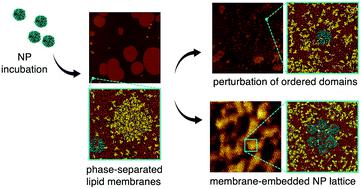Our official English website, www.x-mol.net, welcomes your feedback! (Note: you will need to create a separate account there.)
Amphiphilic gold nanoparticles perturb phase separation in multidomain lipid membranes.
Nanoscale ( IF 6.7 ) Pub Date : 2020-09-17 , DOI: 10.1039/d0nr05366j Ester Canepa 1 , Sebastian Salassi , Anna Lucia de Marco , Chiara Lambruschini , Davide Odino , Davide Bochicchio , Fabio Canepa , Claudio Canale , Silvia Dante , Rosaria Brescia , Francesco Stellacci , Giulia Rossi , Annalisa Relini
Nanoscale ( IF 6.7 ) Pub Date : 2020-09-17 , DOI: 10.1039/d0nr05366j Ester Canepa 1 , Sebastian Salassi , Anna Lucia de Marco , Chiara Lambruschini , Davide Odino , Davide Bochicchio , Fabio Canepa , Claudio Canale , Silvia Dante , Rosaria Brescia , Francesco Stellacci , Giulia Rossi , Annalisa Relini
Affiliation

|
Amphiphilic gold nanoparticles with diameters in the 2–4 nm range are promising as theranostic agents thanks to their spontaneous translocation through cell membranes. This study addresses the effects that these nanoparticles may have on a distinct feature of plasma membranes: lipid lateral phase separation. Atomic force microscopy, quartz crystal microbalance, and molecular dynamics are combined to study the interaction between model neuronal membranes, which spontaneously form ordered and disordered lipid domains, and amphiphilic gold nanoparticles having negatively charged surface functionalization. Nanoparticles are found to interact with the bilayer and form bilayer-embedded ordered aggregates. Nanoparticles also suppress lipid phase separation, in a concentration-dependent fashion. A general, yet simple thermodynamic model is developed to show that the change of lipid–lipid enthalpy is the dominant driving force towards the nanoparticle-induced destabilization of phase separation.
中文翻译:

两亲性金纳米颗粒扰动多域脂质膜中的相分离。
直径在2–4 nm范围内的两亲性金纳米粒子有望成为治疗治疗剂,这是由于它们自发地通过细胞膜转运。这项研究解决了这些纳米颗粒可能对质膜的独特特征产生的影响:脂质侧相分离。结合原子力显微镜,石英晶体微天平和分子动力学研究自发形成有序和无序脂质域的模型神经元膜与具有负电荷表面功能化的两亲性金纳米颗粒之间的相互作用。发现纳米颗粒与双层相互作用并形成双层嵌入的有序聚集体。纳米颗粒还以浓度依赖性方式抑制脂质相分离。一般
更新日期:2020-10-08
中文翻译:

两亲性金纳米颗粒扰动多域脂质膜中的相分离。
直径在2–4 nm范围内的两亲性金纳米粒子有望成为治疗治疗剂,这是由于它们自发地通过细胞膜转运。这项研究解决了这些纳米颗粒可能对质膜的独特特征产生的影响:脂质侧相分离。结合原子力显微镜,石英晶体微天平和分子动力学研究自发形成有序和无序脂质域的模型神经元膜与具有负电荷表面功能化的两亲性金纳米颗粒之间的相互作用。发现纳米颗粒与双层相互作用并形成双层嵌入的有序聚集体。纳米颗粒还以浓度依赖性方式抑制脂质相分离。一般



























 京公网安备 11010802027423号
京公网安备 11010802027423号